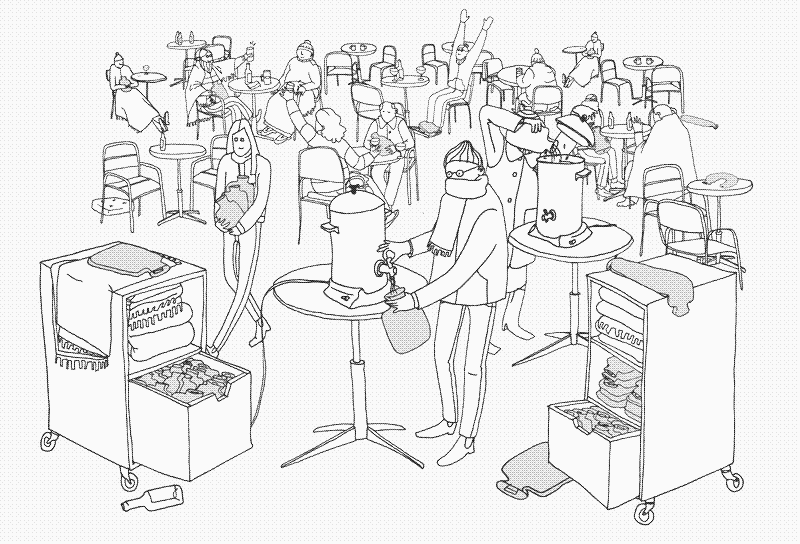Naturally a hot water bottle can get quite hot, but it is anything but energy efficient. Water is the substance with the highest caloric value . Naturally a hot water bottle can get quite hot, but it is anything but energy efficient. Water is the substance with the highest caloric value (4.196 J/gK, Copper has only 0.382), that is, it takes a lot of energy to heat a liter of water and in the bottle in les than 1 h it’s ambient temperature
More efficient are chemical solutions, which heat for many hours with simple and environmentally friendly ingredients. These are mainly used in these thermal patches, which heat up in combination with air and provide heat up to 50ºC for 12 hours and more.
The ingredients could not be simpler, iron filings, sawdust and activated carbon. This mixture, with the humidity of the air, produces this heat by the oxidation of the iron. Later, when they are spent, it can be used even as a nutrient component in the soil for plants.
This makes no sense. Being able to store a lot of heat energy is exactly what you want. Of course it takes more energy to heat water than a sheet of aluminum, but which one is going to stay hotter for longer. Any chemical solution isn’t going to magically get you more energy out than you put in.
True, but a single use chemical reaction might produce heat more efficiently than the stove used to heat the water.
Reusable chemical heat pads that depend on heat stored in an aggregate change from liquid to solid also store more heat per volume than water I think.
you sound right but i don’t trust the internet
A water bottle (~1 liter Water) need a lot of energy to heat the Water and stores the heat for1 Houre, not more. This patches don’t need any energy to heat, no more than the humidity of the environment, to start an exothermic process that lasts between 8-12 Hours, depending on the size of the patch. It requires no more energy than taking it out of the package so that it starts to heat up on its own. It does not require any external energy input, such as heating water electrically, with gas or other fuel, to heat it first, as is the case with the hot water bottle.
You’re not considering the energy required to smelt the iron.
Iron filings (in a collected quantity high enough to make manufacturing these heat packs worthwhile) are not a waste product, they are recycled – saving the smelting of that much new iron.
Sawdust+iron heat packs are a very useful and non-hazardous product, for sure, but aside from situations where a hot water bottle is impractical, hot water bottle still wins.
So… I really don’t know chemistry, and these aren’t the highest quality references, but here goes:
- 4 mol of iron in a heat pack provides 1648.4 kJ of heat. [1]
- 4 mol of iron weighs 223g. [2]
- Recycling 1000kg of steel saves 642 kWh of energy. [3]
- Recycling 0.223kg steel saves 642 * 0.223 / 1000 = ~ 0.143 kWh
- 0.143 * 3600 = 515 kJ
Huh. So maybe heat packs are a reasonable use of scrap iron’s embodied energy after all. Assuming you have a sufficient source of uncontaminated steel filing waste and that it’s economical to collect and process into heat packs.
…But only if you’re heating your water using fossil fuels using an inefficient method! If your water is heated using solar or waste heat capture or a heat pump[4], which would swing the balance way over to hot water bottles again.
I know that iron filings are recycled in foundries, if not used for these patches or for other uses. I am referring to waste that is used by residual products from other manufacturing, which is obviously the case with iron filings and sawdust.
It is true that a well-wrapped hot water bottle can store a little more heat than 1 hour, but not by far the 12 hours of these patches, which are also much more practical in their application, since they can be worn for a day cool comfortably under clothing, or on a sore part of the body, as they are primarily intended, without getting in the way of a job or activity during the day.
For a hot water bottle, you first need to heat the water in the kitchen, which obviously implies an energy expenditure that we have to invest first and that is not necessary in these patches, which in themselves are a source of energy due to a chemical process. . Besides, they are still recyclable afterward, since the iron oxide, product of this chemical reaction, is still usable in foundries, since in any case iron oxide is the form in which this element appears in nature.
These patches are obviously a 100% ecological and recyclable product, containing neither before nor after toxic or polluting residues, not necessarily the same in a hot water bottle, in the manufacture of which various chemical and plastic products are used, which are difficult to recycle (PVC in the cap, several toxic products used in the rubber…)
Iron oxide is not recyclable in a foundry. It would need to go back to a smelter to be smelt into iron again, which I assume is about the same efficiency as smelting iron ore. (Smelting hematite requires ~20 GJ / tonne [1] = ~ 4460 kJ / 0.223kg). Spent iron oxide heat packs are probably best thrown in the compost.
I agree that an iron powder heat pack can be far more practical where a highly portable slow emission of heat are both important for the application. The heat output for something 10% the weight of a water bottle is pretty impressive:
- 1 litre water bottle cooling from 80 C to 40 C:
- ~4kJ/kg⋅K[2] * 40 K * 1 kg = 160 kJ
- 100g heat pack containing 50g iron[3]:
- 50g * 1648kJ / 223g = 369 kJ [4]
Iron powder heat packs need to be stored in suitable packaging (usually plastic) to protect them from moisture and oxygen until their single use.
A hot water bottle needn’t be rubber or plastic.
- 1 litre water bottle cooling from 80 C to 40 C:
Hot water bottles provide warmth for a lot longer than 1 hour. The trick is managing the heat flow with insulation – if you’re using an uninsulated hot water bottle radiating its heat into the air around you then you’re using it wrong.
A hot water bottle wrapped in a wool cover and kept against your body under your blankets will keep the chill off you all night.
This was a very interesting read and the website itself is excellent. Thank you very much for sharing this, OP.
I think a lot of critics of this article are missing the point(s). From a long term/sustainability point of view, hot water bottles make more sense than alternatives like electric heating pads because they (HWBs) are reliant on one very simple thing-- hot water, be it from a kettle, stove top, fire, etc.
Cool article. I love my hot water bottle, don’t know what I’d do without it in winter.
I never quite understood the advantage of this over an electrical heat blanket though.
depends on your main power source i guess
Oat pillows are also a nice way to warm/cool yourself. You can also rest your head on it without any worries of water leakage. Heat one in a microwave for 2 minutes, or put it in the freezer depending on whether you want it to warm or cool you.







